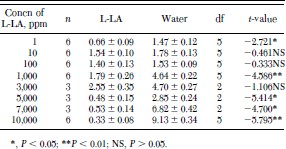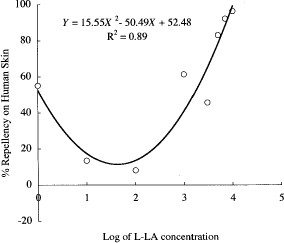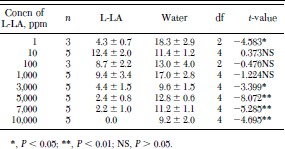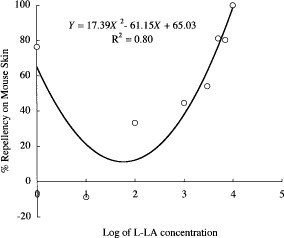-
PDF
- Split View
-
Views
-
Cite
Cite
Yoshikazu Shirai, Kiyoshi Kamimura, Taisuke Seki, Masaaki Morohashi, L-Lactic Acid as a Mosquito (Diptera: Culicidae) Repellent on Human and Mouse Skin, Journal of Medical Entomology, Volume 38, Issue 1, 1 January 2001, Pages 51–54, https://doi.org/10.1603/0022-2585-38.1.51
Close - Share Icon Share
Abstract
The attraction of Aedes albopictus (Skuse) to hands and forearms of human subjects treated with several concentrations of L-LA solution were studied in a test chamber containing proboscis-amputated mosquitoes. Fewer mosquitoes alighted on L-LA treated human skin than on water-treated control skin. Similar results were found using normal mosquitoes following L-LA and water treatment of mouse skin. The relative repellent effects of L-LA varied with concentration. The minimum repellent concentration was lower than previously reported for human skin. The number of alightments decreased at increasing concentrations of L-LA, demonstrating the absolute repellency of L-LA. Unlike previous reports suggesting that L-LA attracted mosquitoes, our studies using human and mouse skin showed that L-LA exhibited both relative and absolute repellency.
Many researchers have reported that L-lactic acid (L-LA) attracts mosquitoes (Acree et al. 1968, Smith et al. 1970, Carlson et al. 1973, Kline et al. 1990, Eiras and Jepson 1994). Acree et al. (1968) isolated L-LA from acetone washings of 800 human arms and demonstrated that L-LA attracted female Aedes aegypti (L.), particularly when CO2 was added. LA is present in human skin and sweat (Robinson and Robinson 1954, Kuno 1956, Gordon et al. 1971). However, King (1954) reported that LA acts as a repellent to mosquitoes when tested on human skin. Smith et al. (1970) showed that the effectiveness of L-LA declined at high concentrations. We have described a new experimental method of assessing the response of Aedes albopictus (Skuse) to repellents (Shirai et al. 2000) and herein compare our results with those reported previously.
Materials and Methods
Mosquitoes.
Four colonies of Ae. albopictus are maintained in our laboratory at 24 ± 1°C, 60–70% RH, and a photoperiod of 14:10 (L:D) h. Colonies originated from Ogaki in Gifu Prefecture, Ako in Hyogo Prefecture, Tsurumi Ryokuchi in Osaka Prefecture, and Ishigaki in Okinawa Prefecture, Japan, and were in generations 2–6 when used for experimentation. Previously we found that 20- to 30-d-old unfed female Ae. albopictus bite more avidly than 3- to 5-d-old females, and these old females (20- to 30-d-old) were used throughout.
Effect of L-LA Treatment on One Forearm.
We adapted an aquarium (600 by 295 by 360 mm; NS-6 M, NISSO, Tokyo, Japan) as a test chamber and introduced mosquitoes into it after amputating their proboscises (Shirai et al. 2000). L-LA (Wako Pure Chemical, Osaka, Japan) was diluted to concentrations ranging from 1 to 10,000 ppm with distilled water. One hand and forearm of each human subject were dipped into the L-LA solution and then allowed to air dry. The other hand and forearm of the same subject were used as the control, proceeding as above with distilled water instead of L-LA. Both hands and forearms were inserted simultaneously into the test chamber. The number of mosquitoes that alighted on the hands and forearms were counted every 30 s for 10 min. Attractancy or repellency was evaluated by comparing the number of alightments on the treated arm with the control for 10 min. Each concentration was repeated three or six times.
Effect of L-LA Treatment on Both Forearms.
Experiments comparing treated and control forearms indicated relative attractiveness or repellency. For determination of absolute attractiveness or repellency, both hands and forearms of each subject were dipped into L-LA solution at the same concentration (1,000–10,000 ppm), dried, and exposed to mosquitoes as above. Three replicates at each concentration were examined.
Effect of L-LA Treatment on Mice.
When using human subjects, we used proboscis-amputated mosquitoes that cannot bite (Shirai et al. 2000). We compared these results to normal mosquitoes (i.e., mosquitoes with complete proboscis) and mouse skin to ascertain whether there is any difference in behavior between amputated and normal mosquitoes, or between human and mouse skin. Normal female mosquitoes were used as test insects, and 4-wk-old hairless mice, anesthetized by intraperitoneal administration of chloral hydrate, were used as bait. One mouse (except for its head) was dipped into L-LA solution and another mouse was dipped into distilled water for 30 s and then both mice were dried with a hair dryer. The test chamber was an aquarium (450 by 300 by 300 mm, YT-8N, Tomofuji, Saitama, Japan) similar to that described above. A plastic vinyl chloride sheet (200 by 300 mm) and an 80-mesh nylon gauze (250 by 300 mm) having an access sleeve was attached to the open side. Treated and control mice were inserted into the test chamber containing 35 normal female mosquitoes, and the number of mosquitoes biting each mouse was counted for 10 min. Three or five replicates were examined at each concentration. All experiments were analyzed statistically using Student t-test by StatView (1998).
Results
Effect of L-LA Treatment on One Forearm.
The relative repellency of L-LA was determined by comparing L-LA-treated and water-treated forearms. Fewer mosquitoes alighted on the treated forearms than on the water controls. L-LA concentrations (except 10, 100, and 3,000 ppm) showed significant differences between each set of forearms (t-test, P < 0.05, Table 1). The percentage of repellency was calculated as 100 × (number on control – number on L-LA)/(number on control). Percentage of repellency (= Y) showed a significant (F = 19.7; df = 2, 5; P = 0.004) parabolic response to the log10 of concentration of L-LA (= X) (Y = 15.55X2 - 50.49X + 52.48) and the relative fit was very high (R2 = 0.89) (Fig. 1). From the minimum value of Y when X = 1.62, the minimum repellent concentration of L-LA was calculated to be 41.7 ppm.
Mean ± SE number of alightments of female Ae. albopictus on L-LA- or water-treated forearms during a 10-min exposure

Mean ± SE number of alightments of female Ae. albopictus on L-LA- or water-treated forearms during a 10-min exposure


Relationship between percent repellency against alighting on human skin and the logarithm of L-LA concentration (ppm). Percentage of repellency was calculated by comparing the number of alightments on L-LA-treated forearms with those on water-treated forearms. Six (1, 10, 100, 1,000, and 10,000 ppm) or three (3,000, 5,000, and 7,000 ppm) replicates were done. In this test, proboscis-amputated mosquitoes were used.
Effect of L-LA Treatment on Both Forearms.
To determine the absolute repellency of L-LA, both forearms were treated with L-LA at various concentrations and then were exposed to mosquitoes. There were no significant differences between the number of alightments on the left and right forearms by t-test at any concentration (Table 2). Furthermore, as the concentration of L-LA increased, the sum of alightments for both forearms decreased; i.e., high concentrations of L-LA repelled the mosquitoes.
Mean ± SE number of alightments of female Ae. albopictus on similarly L-LA-treated forearms during a 10-min exposure

Mean ± SE number of alightments of female Ae. albopictus on similarly L-LA-treated forearms during a 10-min exposure

Effect of L-LA Treatment on Mouse Skin.
Similar to the above tests, mice treated with L-LA showed repellency. When normal mosquitoes and mice were used instead of mosquitoes lacking proboscises and human forearms, L-LA acted as a repellent (Tables 3; Fig. 2). Again, L-LA concentrations (except 10, 100, and 1,000 ppm) showed significant differences between L-LA-treated and water-treated skin by t-test. From the significant (F = 10.1; df = 2, 5; P = 0.017) parabolic curve (Y = 17.39X2 - 61.15X + 65.03; Y = percent repellency on mouse skin, X = log10 of concentration for L-LA) with a high relative fit (R2 = 0.80), the minimum repellency concentration was calculated to be 61.7 ppm when X = 1.79.
Mean ± SE number of bites by female Ae. albopictus on L-LA- or water-treated mouse skin during a 10-min exposure

Mean ± SE number of bites by female Ae. albopictus on L-LA- or water-treated mouse skin during a 10-min exposure


Relationship between percent repellency against mouse skin and the logarithm of L-LA concentration (ppm). Percentage of repellency was calculated by comparing the number of bites on L-LA-treated mouse skin with those on water-treated mouse skin. Five (10, 1,000, 3,000, 5,000, 7,000, and 10,000 ppm) or three (100 and 1,000 ppm) replicates were done. In this test, normal mosquitoes were used.
Discussion
Smith et al. (1970) suggested that under some conditions LA could act as a repellent, whereas under others it acted as a true attractant. Carlson et al. (1973) showed that 50 μg of L-LA was the most attractive amount tested, and these results were similar to data obtained using L-LA ranging from 5 to 600 μg by Smith et al. (1970). Our result showing an optimal concentration of L-LA that does not repel mosquitoes is consistent with Smith et al. (1970) and Carlson et al. (1973). Our experiments showed that high and low concentrations repelled mosquitoes. Repellency at the high range was consistent with reports by Brown et al. (1951), but repellency at the low range conflicted with previous reports. Results that all concentrations displayed repellency are similar to Rudolfs (1922) and Skinner et al. (1968). King (1954) described that LA acted as a repellent to mosquitoes when applied to human skin, consistent with our results. In tests of both L-LA treated forearms, repellency increased proportionally to the concentration. However, previous reports concluded that L-LA acted as an attractant regardless of concentration. Naturally, LA exists on human skin in sweat. Kuno (1956) showed that sweat contains 35 mg % LA, and Robinson and Robinson (1954) showed that the concentration of LA ranges from 4 to 40 mEq. per liter of sweat. Both reports showed similar concentrations of LA in sweat; 350–3,600 ppm, and this same range was used in our experiments. Also, Thurmon and Ottenstein (1952) discussed how the LA concentration in sweat might differ between genders, being greater in males than in females.
The minimum repellency concentration of L-LA in our experiments was ≈41.7 ppm, lower than that present on human skin. Furthermore, Dill et al. (1938) and van Heyningen and Weiner (1952) found that the amount of LA in arm sweat was 1.5- to threefold greater than in total body sweat. Therefore, the concentration of L-LA applied to the skin in our experiments might actually be higher when added to the natural amount of LA on forearms. However, because our experiments were done at 23°C, a temperature at which measurable perspiration usually does not occur, interference by natural LA appeared to be minimal. In addition, we obtained similar results in tests with mice that do not sweat.
Mosquitoes such as Ae. aegypti have LA-excited neurons of the antennal grooved-peg sensilla, and the LA sensitivity is influenced by sucrose-feeding, blood-feeding, and oviposition (Davis 1984a, 1984b). Moreover, there is a pair of neurons sensitive to one chemoreceptor responding to LA in the grooved-peg (A3) sensilla. One of them responds to LA with an increase in spike frequency, whereas the other chemoreceptor exhibits a decrease when presented with LA (Davis and Sokolove 1976). The different function of these two chemoreceptors may explain both the attractiveness and the repellency of Aedes mosquitoes to LA.
The attraction of mosquitoes to human sweat has been reported previously (Rudolfs 1922, Khan et al. 1969), whereas others have reported on its repellency (Smart and Brown 1956). This controversy was discussed by Skinner et al. (1965). Brown et al. (1951) showed that sweat was significantly attractive at a low vapor concentration, but was significantly repellent at a high concentration. van Heyningen and Weiner (1952) assumed that the high lactate concentration in sweat was not derived from plasma but was from the metabolism of the sweat gland itself. However, Gordon et al. (1971) reported that sweat lactate in humans was derived from blood glucose. On the other hand, Sato (1977) described that at low sweat rates the lactate concentration was as high as 30–40 mM, but rapidly dropped to a plateau at around 10–15 mM as the sweat rate increased. Therefore, the sweat lactate concentration seems to be related to the sweat rate. The divergence of results among researchers on the attraction or repellency of sweat to mosquitoes might depend on the concentration of LA in sweat.
Lactic acid also is related to physiological condition and disease. For example, lactic acidosis is a human sickness in which blood lactate concentrations become abnormally high (Huckabee 1961, Kreisberg 1980). Similarly, accumulation of large amounts of LA in blood occasionally causes problems in the human body. From our observations, mosquitoes might avoid large amounts of LA on human skin, so as to prevent imbibing LA-abundant blood. Currently, the effect of LA-rich blood in mosquito blood meals is unknown.
Acknowledgements
We thank several students at the Toyama Medical and Pharmaceutical University for their help in our experiment. We also thank Ines Tomoco Matsuse for reviewing the manuscript and Hisashi Funada for valuable suggestions.
References Cited



